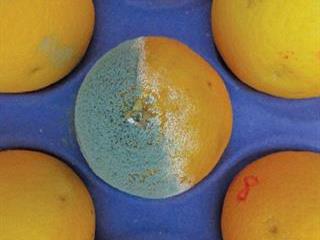
According to the Perishable Products Export Control Board, 498 483 out of 1 939 437 cartons of citrus were rejected during the past season due to fungal diseases. Green mould (Penicillium digitatum) alone accounts for 90% of all post-harvest losses.
However, these figures could be greatly reduced by basic practices such as good sanitation and the correct products used correctly, Citrus Research International (CRI) post-harvest pathologist Dr Arno Erasmus told a CRI workshop in Stellenbosch recently.
- The orchard
Prevention starts in the orchard. Fungal spores are everywhere, so fruit must be carefully picked and handled to minimise open wounds that can be infected, explains Charmaine Christie, a Masters student at the Department of Plant Pathology at Stellenbosch University. Infected fruit must be separated and destroyed as soon as possible, whether in the orchard or in the packhouse.
- The packhouse
“The packhouse must have an area where fruit can be delivered and separated to eliminate infected fruit,” says Erasmus.
“Fruit for the juice market must be removed from the area as soon as possible as it can turn into a breeding ground for diseases and fungicide resistance development. There must be zero tolerance of any fruit remaining on the premises for longer than a day.”
A well-positioned extractor canopy and a packhouse designed for optimal air flow can contribute to removing spores.
“Consider the fruit flow in a packhouse and design it to reduce risks, leaving little opportunity for contamination,” he says.
- Fruit washing
Washing fruit before fungicide or wax treatment is standard practice in a citrus packhouse as it removes fungal spores and bacteria and keeps the packline and equipment clean, explains Erasmus. But many packhouses fail to do this properly, causing more harm than good as the water itself becomes a source of contamination when dirty.
Although most South African producers use chlorine to disinfect water, chlorine dioxide and hydrogen peroxide are also suitable. Chlorine removes electrons from organic substances such as dust, bacteria and fungi, destroying the cell walls of microorganisms.
“Chlorine’s ability to fulfill this function declines as more electrons are added to it,” explains Erasmus. “So the dirtier the water becomes, the faster the chlorine loses its ability to kill pathogens.”
Chlorine is three times more effective at pH 7 than pH 8, at which the level of available chlorine drops to only 25%. For best results, chlorine should be used according to the instructions at a pH between 6,5 and 7,5 and a concentration of 150ppm to 200ppm (parts per million), advises Erasmus.
- Sanitation
For fruit sanitation, he has found that a dry tip system is superior to a wet dump system. In the latter, the fruit is dumped into a chlorine solution, whereas in the former, a chlorine solution is sprayed onto fruit and the solution is not recycled.
CASE STUDY
In a recent case study, one packhouse used a chlorine dip tank at a chlorine level of 62ppm at pH 8,2, exposing the fruit to the solution for 90 seconds. Another packhouse used a non-recycling dry tip system, spraying fruit for five seconds with a 134ppm chlorine solution at pH 8,5.
For controls left untreated (wounded and not chlorine treated), the first packhouse had a green mould infection rate of 39%.
Erasmus attributes this to the producer using a de-greening facility that increased the spore level in his packhouse. Since de-greening was omitted at the second packhouse and spore levels were low, this packhouse suffered none of these losses.
When fruit was artificially inoculated, green mould infected 75% and sour rot 78% of the fruit in the first packhouse. By contrast, green mould infected only 11% of the fruit in the packhouse where the fruit was only sprayed with the sanitising solution, and no fruit became infected with sour rot.
The same trend was seen with various other treatments. A packhouse using a chlorine dip tank always had the highest infection rate.
Erasmus ascribes the success of the dry tip system to the fact that the sanitation medium covers the fruit entirely, whereas it is difficult to ensure such coverage in a dip tank. The dry tip system is also easier to keep clean and retain chlorine at an optimal level. (Consult the table to compare the two systems.)
- Fungicide
By applying fungicide, growers can significantly reduce fruit loss. But Charmaine emphasises that fruit must be drenched and treated with a fungicide as soon as possible after picking, to reduce the infection risk. “For curative control, drench citrus in a fungicide within 24 hours of picking, not 24 hours after arriving at the packhouse,” she advises. “Lemons and navels have a few hours leeway.
“It’s easier to cure fruit infection than to try to protect fruit from infection or prevent green mould from sporulating later. “In my studies, I’ve found that fungicide drenching inhibits sporulation in clementines by 35% to 55%, in navels by 40% to 60% and in lemons by only 30% to 40%.”
She stresses the need to use fungicides correctly according to instructions. “Agitate the fungicide solution constantly, otherwise the fungicide will sink to the bottom of the tank where it will become unavailable and yield less effective control. Replace the fungicide solution after every 300 bins to maintain its efficacy.”
- Heated flooder
Most citrus farmers dip their fruit in a fungicide solution as the main in-line treatment. But Catherine Savage, a technician at CRI and a Masters student at the Department of Plant Pathology at Stellenbosch University, has found a heated flooder to be superior.
She explains that it affords better control over pH, temperature, exposure time and fungicide concentration. As it is smaller, it is also more energy- and water- efficient than a dip tank. The flooder works with a waterfall mechanism. In the event of an electric outage, fruit is not left in the fungicide solution as in the case of a dip tank.
It also gives excellent fruit coverage, as the fruit is submerged and rolled over brushes for five seconds. A dip tank, by contrast, achieves only partial coverage as the fruit and the tank itself often act as a buffer that prevents full coverage.
The flooder also significantly reduces the risk of exceeding maximum residue limit (MRL) on fruit.
“In the dip tank, if the pH and fungicide concentration are not managed correctly, an exposure time exceeding 45 seconds could result in an overload of fungicide,” Savage explains. In her studies, she found the flooder to give the most efficient green mould control and sporulation inhibition at a fungicide solution of 500ppm and a pH of 6. “Using the fungicide at pH 6 requires a strict exposure time, but the flooder is very consistent in achieving it,” she explains.
- Resistance
Fungicide resistance is becoming an increasing threat, especially to producers who use fungicides to combat citrus black spot. To reduce this threat, producers have to sanitise the fruit, clean packhouse surfaces such as the floor, packline, walls and roof, and remove inoculants that could infect fruit.
“The more spores that are present in the air, the higher the chance for decay and the development of resistance,” says Erasmus. “No packhouse worker should continue with any other task after spotting a blue or green moulded fruit. This should be disposed of right away. Everything in the packhouse is at risk from that infected fruit.
“A solid waste removal plan must be in place, and this should be executed [by the] hour, with infected fruit placed in closed containers.” He emphasises that fungicides should be used according to instructions, as over- or under-dosing can compromise disease control or result in the minimum resistance level being exceeded. Products should also be varied according to their mode of action to combat fungicide resistance development.
Finding the cause
An example cited by Erasmus demonstrates how fruit infection can come about. A farmer experienced fungicide resistance in his packhouse. Called for assistance, Erasmus identified many factors contributing to the problem along the packing line. The main culprit, however, was a new fruit sizer with exposed screws that damaged the fruit. The open wounds rendered the fruit highly vulnerable to infection even after having been treated with a fungicide and waxed.
There was also a room with an open section facing the packhouse, alongside the fruit sizer. This contained large quantities of sporulating fruit, at least one per carton. Erasmus was fairly certain that these spores had started to become resistant, as the situation had long remained unchanged.
Contact Dr Arno Erasmus at 013 759 8000 or [email protected].













